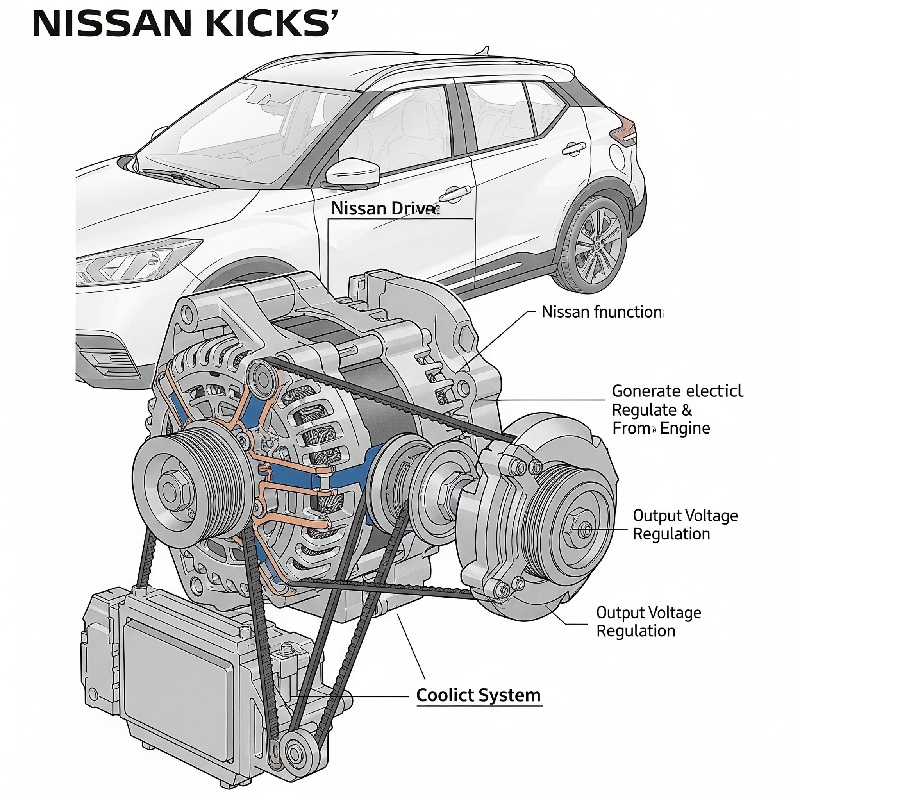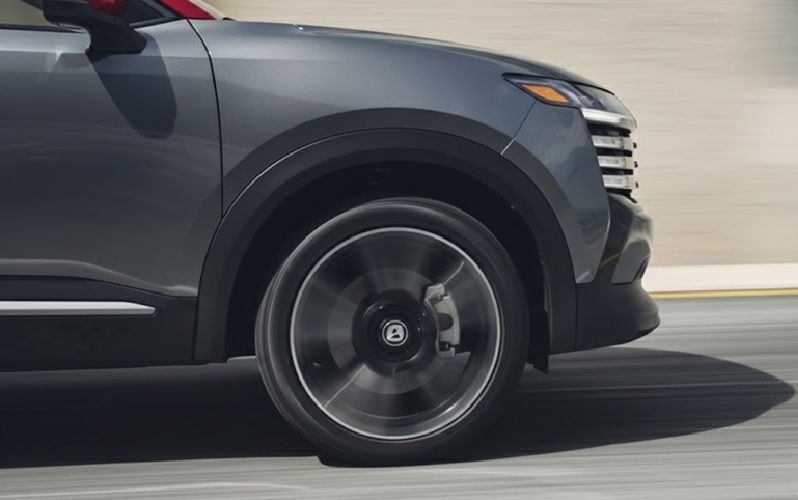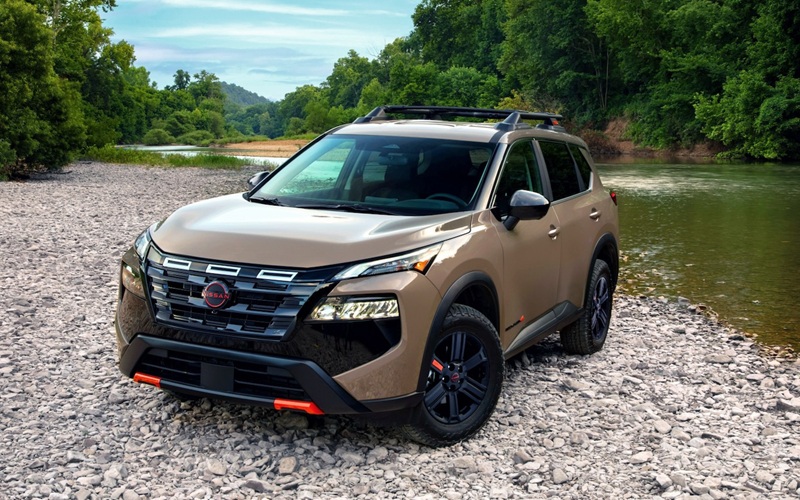The Nissan Kicks Alternator System: Functions and Features
The Nissan Kicks has quickly established itself as a popular compact crossover, combining style, efficiency, and reliability in an attractive package. While many drivers focus on engine performance, fuel economy, and technology features, one critical component often goes unnoticed: the alternator system. This vital piece of automotive engineering is essential to the vehicle’s operation, powering […]
The Nissan Kicks has quickly established itself as a popular compact crossover, combining style, efficiency, and reliability in an attractive package. While many drivers focus on engine performance, fuel economy, and technology features, one critical component often goes unnoticed: the alternator system. This vital piece of automotive engineering is essential to the vehicle’s operation, powering everything from essential functions to convenience features.

The Heart of Electrical Power
The Nissan Kicks features a robust 120-amp alternator designed to meet the demands of its modern electrical systems. This component serves as the vehicle’s power generation station, converting mechanical energy from the engine into electrical energy that powers the vehicle’s systems and recharges the battery. When the engine runs, a drive belt connects the crankshaft to the alternator pulley, spinning a rotor inside the alternator to generate electricity through electromagnetic induction.
The 120-amp rating indicates the maximum current output the alternator can produce. This capacity ensures sufficient power generation for all the electrical components, from essential systems like ignition and fuel injection to convenience features like climate control, infotainment, and USB charging ports. The alternator’s output is crucial in Kicks models equipped with advanced driver assistance technologies that require consistent and reliable electrical power.
Integration with Vehicle Systems
In the Nissan Kicks, the alternator system seamlessly integrates with the vehicle’s engine management system. The Engine Control Module (ECM) monitors battery voltage and electrical load requirements, adjusting the alternator’s output accordingly to meet these requirements. This intelligent management helps optimize fuel efficiency by reducing unnecessary alternator load when the electrical system doesn’t require maximum output.
The alternator also works in tandem with the battery management system. When the vehicle’s electrical demand exceeds what the alternator can supply momentarily—such as during idle with multiple systems running—the battery supplies the additional power needed. The alternator then recharges the battery once the load decreases or the engine speed increases.
Construction and Durability
The alternator in the Nissan Kicks features a durable construction designed to withstand years of operation under varying conditions. Its internal components include:
- A rotor assembly with copper windings around an iron core
- Stator windings that surround the rotor
- Diode rectifiers that convert AC power to DC power
- A voltage regulator that maintains a consistent output voltage
- Heavy-duty bearings supporting the rotor shaft
- Cooling mechanisms to dissipate heat during operation
These components are in a compact aluminum casing that helps dissipate heat efficiently. The design prioritizes durability while minimizing weight, contributing to the overall efficiency goals.
Maintenance Considerations
The alternator system in the Nissan Kicks typically lasts well over 100,000 kilometers under normal driving conditions. However, several factors can affect its lifespan:
Extreme operating conditions, such as consistent short trips or operation in extremely hot environments, can place additional stress on the alternator. Regular vehicle maintenance, including proper tension of the drive belt, helps ensure optimal alternator performance and longevity.
Warning signs of alternator issues include dimming headlights, dashboard warning lights, slow functioning of electrical accessories, unusual noises from the engine bay, or difficulty starting the vehicle. If these symptoms appear, diagnostic testing can determine if the alternator is functioning properly.
Evolution and Efficiency
The alternator system in the latest Nissan Kicks models reflects advances in automotive electrical engineering. Compared to alternators from decades past, the current system delivers more power while operating more efficiently. This efficiency translates to reduced engine load and improved fuel economy.
The integration of smart charging systems in newer Kicks models further enhances efficiency. These systems can adjust the alternator output based on driving conditions and electrical demands, thereby reducing engine load during acceleration or when the battery is fully charged.
Things You Didn’t Know About the Nissan Kicks Alternator System
- The alternator in the Nissan Kicks initially produces alternating current (AC), which is then converted to direct current (DC) by diodes inside the unit before powering the vehicle’s systems.
- At idle, the alternator produces significantly less power than its 120-amp rating, which is why running multiple high-draw accessories while idling can sometimes drain the battery.
- The voltage regulator in the Kicks alternator adjusts output approximately 15-20 times per second to maintain optimal voltage for the vehicle’s electrical system.
- Modern Kicks alternators feature a decoupler pulley that enables the alternator to “freewheel” momentarily during engine deceleration, thereby improving efficiency and reducing belt wear.
- The alternator in the Nissan Kicks operates efficiently in ambient temperatures ranging from -40 to 50 degrees Celsius, maintaining consistent output despite challenging environmental conditions.
Questions and Answers About the Nissan Kicks Alternator System
What is the amperage rating of the Nissan Kicks alternator?
- It features a 120-amp alternator, providing sufficient electrical power for all vehicle systems and accessories.
How does the alternator recharge the battery in the Nissan Kicks?
- The alternator generates electrical current when the engine runs, sending this power to both the vehicle’s electrical systems and the battery to maintain its charge.
What are the common symptoms of alternator problems in the Nissan Kicks?
- Common symptoms include dimming headlights, dashboard warning lights, slow functioning of electrical accessories, unusual noises from the engine bay, and difficulty starting the vehicle.
How long should the alternator last in a Nissan Kicks?
- Under normal driving conditions, the alternator typically lasts well over 100,000 kilometers, though factors like driving habits and environmental conditions can affect its lifespan.
Does using more electrical accessories in the Kicks affect fuel economy?
- Yes, running multiple high-draw electrical accessories increases the load on the alternator, which requires more engine power and can slightly reduce fuel efficiency.
Can the alternator in the Nissan Kicks be rebuilt?
- Yes, alternators can often be professionally rebuilt, replacing worn components while retaining the original housing and certain internal parts.
How does extreme cold affect the alternator in the Nissan Kicks?
- Extreme cold can increase the viscosity of the lubricant in the alternator bearings, creating additional resistance and potentially reducing efficiency until the unit warms up.
Is the alternator responsible for charging mobile devices in the Nissan Kicks?
- Yes, the alternator provides power to the USB ports and 12V outlets, though the power is converted and regulated through the vehicle’s electrical system before reaching your devices.
What happens if the alternator fails while driving the Nissan Kicks?
- If the alternator fails while driving, the vehicle will run on battery power until the battery depletes, gradually losing electrical functions before eventually stalling.
Does the alternator in the Kicks produce consistent power at all engine speeds?
- No, the alternator’s power output increases with engine RPM, producing less power at idle and more at higher engine speeds.


